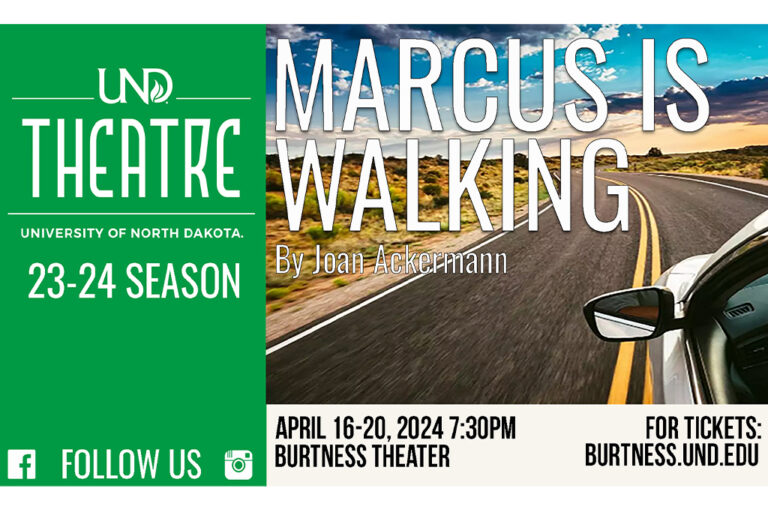Robots with a good beat
UND Music hosts expert composer roboticist for interdisciplinary workshop on mechanical music

Hovering over a group of 10 people, busy screwing bolts and placing cogs, Troy Rogers teased as much as he advised.
“You need to think from the perspective of the robot and it will start to make sense,” he quipped.
Everyone was building their own “Dr. D,” or a desktop robotic drummer. In its finished form, the gadget resembled a crab with black mallets instead of claws and a frosted acrylic sheet for a shell.
To get to this shape, however, it had to morph through several stages of assembly over a three-hour workshop. Hosted by the University of North Dakota’s Music Department, the workshop capitalized on Rogers’ robotics expertise.
More than a geeky get-together, the event attracted attendees from the fields of music and engineering. It showed the exhilarating possibilities that emerge at the confluence of the two disciplines, said Music Department Chair Katherine Norman Dearden.
Watch this clip of a “Dr. D” drumming robot in action.
Roboticist by vocation
Rogers is a composer roboticist. He heeds his fascination for sound by devising various machines that make music. A layman may see his robots as outlandish or newfangled, but in the grand fold of music history, they are anything but novel.
“There is nothing new about this fusion of high technology and [music],” said Rogers, as he talked about centuries-old Hellenistic automated water organs and Arabic wax cylinders that capture movement.
Today, humanoid robots – the electronic stuff of sci-fi flicks and futuristic exhibits – may grip people’s imaginations, but it is their seemingly rudimentary counterparts that trigger Rogers’ ingenuity.
“When I first started making robots, I thought, ‘Oh, this will allow all of these things to happen,’” he said. “But where it has put me musically is in a much rawer place and it has simplified my process a lot.”
The simplicity of Rogers’ musical robots is deceptive, though. His contrivances gobble a slew of parts – some of which he makes, others like computer chips he orders. They also exact quite the dedication.
After 15 years of robots making – a vocation that sprouted by tweaking instruments – Rogers said he doesn’t own as many as he thought he would. After all, they take a lot of time to come together.

On your own
This fact dawned at the UND workshop quite early on. Participants toyed with small pieces, slowly joining them in bursts of thrilling advancements and sudden setbacks. Once they completed a construction phase (say, attaching the mallets to the body), Rogers placed more components on gray tables in front of them.
“There were some things that I didn’t really understand, but I think I got it together as well as I could,” said Katherine Woolsey, music education major as she looked down on her Dr. D.
Woolsey’s mindset of doing-a-decent-not-necessarily-a-perfect job appeared to encapsulate Rogers’ own tenets. If he were an engineer, he would obsess over shortcomings and shockers, he said. But as a musician, he revels at them.
“You think you are going to make something that kind of plays like a guitar,” Rogers said. “But then you find out that, ‘Oh, it can trill at audio rates,’ which means faster than you can even see the thing moving. Suddenly, that has a whole new effect.
Each of these machines – if you play with them – they have their own voices.”
It is this sort of creator’s discovery that Michael Wittgraf, music professor at UND, hoped to inculcate at Rogers’ workshop, which he organized and where he constructed a robot himself.
“So many people are not exposed to something like this, but it is the basic concept of ‘figure it out for yourself,’” said Wittgraf. “If you want to do something, you do not have to have somebody teach you. You could figure it out.”
Check out the interesting performance by Troy Rogers and his ‘bots.
‘Alive’ and drumming
After nearly three hours, all 10 newly-minted robotics tinkerers saw their Dr. Ds come to life. They awoke after a short jolt from Rogers’ computer that fed them an open-source code. The latter could be teased to prompt different effects and fine tune the main rhythm of Steve Reich’s classic clapping music.
Dr. D after Dr. D began drumming, striking the surface in mismatched tunes and prompting smiles and gasps.
“When it all happens, that moment is magic,” said Rogers. “It is always magic even if I have seen it happen hundreds of times now.”
Later, on Oct. 1, Rogers performed with his robots during a public recital at UND’s Hughes Fine Arts Center.


